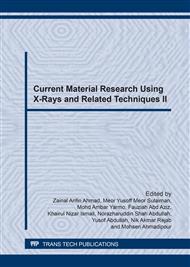[1]
A. B. Salleh, Toughening of epoxy with modified liquid natural rubber and acrylanitrile-butadiene liquid rubber. Doctoral Thesis, Universiti Sains Malaysia, Penang, Malaysia (2005).
Google Scholar
[2]
A.H. Razaiferd, K.A. Hodd, J.M. Barton, Toughened Plastics I-Science and Engineering, edited by C.K. Riew and A.J. Kinloch (American Chemical Society, Washington, DC, 1993) chapter 16 (1993) 233-382.
Google Scholar
[3]
C.K. Riew, Amine terminated reactive liquid polymers; modification of thermoset resins, Rubber Chem. Technol, 54(2) 1981 374-402.
DOI: 10.5254/1.3535812
Google Scholar
[4]
D. Ratna, A. K. Bantia., Rubber toughened epoxy, Macromolecular Research, 12(1) (2004) 11-21.
Google Scholar
[5]
M.M.B. Bump, The Effect of Chemistry and Network Structure on Morphological and Mechanical Properties of Diepoxide Precursors and Poly(Hydroxyethers), Doctoral Thesis, Faculty of the Virginia Polytechnic Institute and State, Blacksburg, Virginia, (2001).
Google Scholar
[6]
F. Vahedi, H.R. Shahverdi, , M.M. Shokrieh, M. Esmkhani, Effects of carbon nanotube content on the mechanical and electrical properties of epoxy-based composites, New Carbon Materials, 29(6) (2014) 419-425.
DOI: 10.1016/s1872-5805(14)60146-3
Google Scholar
[7]
F. El-Tantawy, K. Kamada, H. Ohnabe, In situ network structure. Electrical and thermal properties of conductive epoxy resin-carbon black composites for electrical heater applications, Mater. Lett. 56 (2002) 112-126.
DOI: 10.1016/s0167-577x(02)00401-9
Google Scholar
[8]
F.Y.C. Boey, W.J. Qian, Determining the gel point of an epoxy-hexaanhydro-4-methylphtalic anhydride (MHHPA). J. Appl. Polym. Sci., 76 (2000) 1248-1256.
DOI: 10.1002/(sici)1097-4628(20000523)76:8<1248::aid-app5>3.0.co;2-0
Google Scholar
[9]
P. Phinyocheep, J. Saelao, J.Y. Buzare, Mechanical properties, morphology and molecular characteristics of poly(ethylene terephthalate) toughened by natural rubber, Polymer, 48 (2007) 5702-5712.
DOI: 10.1016/j.polymer.2007.07.016
Google Scholar
[10]
A.J. Kinloch, S.J. Shaw, D. L. Hunston, Deformation and fracture behaviour of a rubber-toughened epoxy: 1. Microstructure and fracture studies, Polymer, 24(10) (1983) 1341-1354.
DOI: 10.1016/0032-3861(83)90070-8
Google Scholar
[11]
J. Sandler, M.S.P. Shaffer, T. Prasse, W. Bauhofer, K. Schulte, A.H. Windle, Development of a despersion process for carbon nanotubes in an epoxy matrix and the resulting electrical properties, Polymer , 40 (1999) 5967-5961.
DOI: 10.1016/s0032-3861(99)00166-4
Google Scholar


